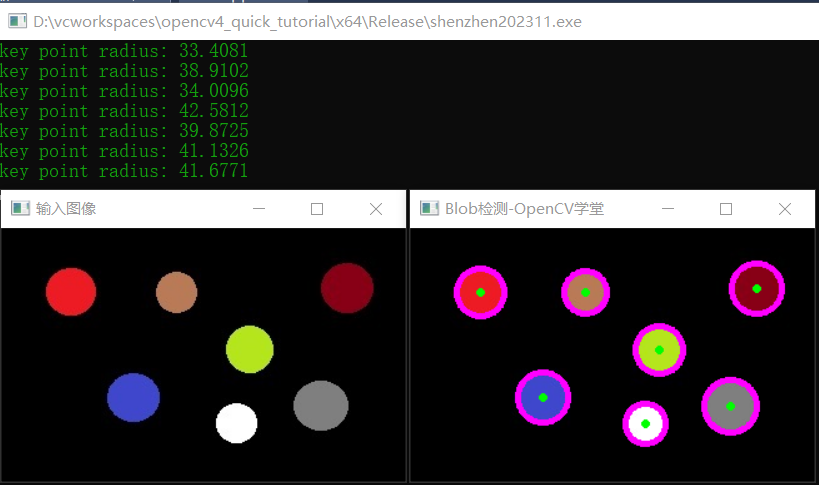

OpenCV4图像分析之BLOB特征分析
描述
Blob分析
BLOB是图像中灰度块的一种专业称呼,更加变通一点的可以说它跟我们前面二值图像分析的联通组件类似,通过特征提取实现常见的各种灰度BLOB对象组件检测与分离。使用该检测器的时候,可以根据需要输入不同参数,得到的结果跟输入的参数息息相关。
Blob分析函数与演示
OpenCV中的Blob分析函数为SimpleBlobDetector,OpenCV中支持实现常见的BLOB分析过滤,如下所示:
-根据BLOB面积过滤 -根据灰度/颜色值过滤 -根据圆度过滤 -根据长轴与短轴过滤 -根据凹凸进行过滤
对应的参数列表如下:
SimpleBlobDetector::Params() bool filterByArea bool filterByCircularity bool filterByColor bool filterByConvexity bool filterByInertia float maxArea float maxCircularity float maxConvexity float maxInertiaRatio float maxThreshold float minArea float minCircularity float minConvexity float minDistBetweenBlobs float minInertiaRatioOpenCV中Blob检测示例代码如下:
#include "opencv2/opencv.hpp" #include演示效果如下:using namespace cv; using namespace std; int main(int argc, char** argv) { // 加载图像 Mat src = imread("D:/lena.jpg"); Mat gray; cvtColor(src, gray, COLOR_BGR2GRAY); cv::imshow("输入图像", src); // 初始化参数设置 SimpleBlobDetector::Params params; params.minThreshold = 10; params.maxThreshold = 240; params.filterByArea = true; params.minArea = 50; params.filterByCircularity = true; params.minCircularity = 0.1; params.filterByConvexity = true; params.minConvexity = 0.5; params.filterByInertia = true; params.minInertiaRatio = 0.5; // 创建BLOB Detetor Ptr detector = SimpleBlobDetector::create(params); // BLOB分析与显示 Mat result; vector keypoints; detector->detect(gray, keypoints); for (auto kpt : keypoints) { std::cout << "key point radius: " << kpt.size << std::endl; cv::circle(src, kpt.pt, 2, cv::Scalar(0, 255, 0), 2, 8, 0); cv::circle(src, kpt.pt, kpt.size/2, cv::Scalar(255, 0, 255), 3, 8, 0); } imshow("Blob检测-OpenCV学堂", src); waitKey(0); }

特殊使用技巧
SimpleBlobDetector 函数有两个很诡异的地方。 第一个是实现的默认参数支持与参数检查 OpenCV中SimpleBlobDetector函数默认的参数值如下:
thresholdStep = 10; minThreshold = 50; maxThreshold = 220; minRepeatability = 2; minDistBetweenBlobs = 10; filterByColor = true; blobColor = 0; filterByArea = true; minArea = 25; maxArea = 5000; filterByCircularity = false; minCircularity = 0.8f; maxCircularity = std::numeric_limits每次执行之前都会进行断言检查,但是OpenCV中同时提供了是否启用Blob各种过滤开关选项,但是无论开关选项是否启用,这个断言检查都是检查全部属性值,这个就导致你设置选项为false的时候,必须填写对应选项的选项值,否则就无法执行Blob检测函数。对应的源码文件 blobdetector.cpp 发现了这段代码作为佐证:::max(); filterByInertia = true; //minInertiaRatio = 0.6; minInertiaRatio = 0.1f; maxInertiaRatio = std::numeric_limits ::max(); filterByConvexity = true; //minConvexity = 0.8; minConvexity = 0.95f; maxConvexity = std::numeric_limits ::max(); collectContours = false;
static void validateParameters(const SimpleBlobDetector::Params& p)
{
if (p.thresholdStep <= 0)
CV_Error(Error::StsBadArg, "thresholdStep>0");
if (p.minThreshold > p.maxThreshold || p.minThreshold < 0)
CV_Error(Error::StsBadArg, "0<=minThreshold<=maxThreshold");
if (p.minDistBetweenBlobs <=0 )
CV_Error(Error::StsBadArg, "minDistBetweenBlobs>0");
if (p.minArea > p.maxArea || p.minArea <=0)
CV_Error(Error::StsBadArg, "0 p.maxCircularity || p.minCircularity <= 0)
CV_Error(Error::StsBadArg, "0 p.maxInertiaRatio || p.minInertiaRatio <= 0)
CV_Error(Error::StsBadArg, "0 p.maxConvexity || p.minConvexity <= 0)
CV_Error(Error::StsBadArg, "0
第二个是现实的默认输入图像的背景必须是白色 如果是黑色背景图像输入,Blob检测所有的参数就直接失效了,但是官方开发教程示例代码与函数文档都没有说明这点,导致很多新手小白不明所以就直接掉坑了,然后就放弃使用这个函数了。
审核编辑:黄飞
声明:本文内容及配图由入驻作者撰写或者入驻合作网站授权转载。文章观点仅代表作者本人,不代表电子发烧友网立场。文章及其配图仅供工程师学习之用,如有内容侵权或者其他违规问题,请联系本站处理。
举报投诉
-
OpenCV4.8 CUDA编程代码教程2023-12-05 2193
-
Vivado HLS实现OpenCV图像处理的设计流程与分析2021-07-08 5241
-
纹理特征分析及特征量计算2009-03-01 2213
-
基于OpenCV的图像特征智能识别系统设计2015-12-31 1064
-
OpenCV3.1的使用教程之图像特征描述的详细资料说明2020-01-06 1001
-
基于OpenCV3.1的图像特征描述功能实现2021-03-29 743
-
基于OpenCV如何提取中心线2021-04-26 4524
-
基于opencv4和Yolo-Fastest,实现PC和单片机通信,控制步进电机捕获目标2021-11-23 880
-
如何在Raspberry Pi 3上安装OpenCV4库2022-09-08 2386
-
OpenCV4中SIFT算法概述2022-11-23 2093
-
OpenCV4源码分析2023-02-22 1791
-
学习OpenCV4的系统化路线图2023-07-05 1223
-
OpenCV二值图像分析2023-10-20 1134
-
OpenCV4笔记之连通域分析2023-12-25 2083
-
OpenCV4之图像的轮廓2024-01-02 1373
全部0条评论

快来发表一下你的评论吧 !

